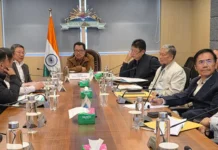Monday Musing
[ Karyir Riba ]
The religious belief system of the indigenous people of Arunachal has always been distinguishable from the other ‘mainland religions’. This is, in fact, the same for the indigenous people the world over.
The indigenous religious belief system is basically associated very strongly with nature, and the higher spirits of the natural world. They believe in living in harmony with nature, and worship nature – the sun, the moon, the rivers, the mountains, the forests – which gave life to the human race and all other living organisms since the very beginning of life.
These systems do not have any formal teachings. These are passed on orally, through chants and hymns, and through ritualistic practices that the community performs by coming together. These beliefs are intertwined with their traditional lifestyle and culture.
Shamanism is a way of life for the indigenous people to stay connected with their natural spirit world as they believe in an unseen spirit world that influences human affairs, and the mediation between the two is performed by shamans.
A shaman is considered to have special powers to communicate with the spirit world – often used as a synonym for a traditional healer.
If we speak of the Idu Mishmi community of Arunachal, the shamans, or igu in the local term, hold a high and important place in the community. The community showcases one of the most, if not the most, structurally and systematically built traditional shamanic system.
Right from one’s conception to one’s funeral, and everything in between, it is the igu who conduct rituals and work as mediums to connect a person to the spiritual world.
During pregnancy, usually at the onset of the second trimester, a ritual called areibi or aiibi is performed to bless the unborn baby and its mother, and to protect them from any evil.
After the child is born, the igu blesses the child and holds a ritual for the wellbeing of the newborn – ataye, followed by angethunu. In case of a female baby, ataye is performed four days from her birth, followed by angethunu on the eighth day. For males, ataye is performed on the fifth day from his birth, followed by angethunu on the tenth.
Machiwuhi and kanliwuhi are rituals conducted to cleanse a child, or a grownup, from any illnesses or from evil eye. Water is used in the former, while a kind of local ginger is used for the later.
Like so, there are rituals like apeshu, tano, ayi, for cleansing after meeting with accidents. Aerochika is done in case of fire incidents; amrasé is done for cleansing and protection, mostly after occurance of some mishap. Ibicha is performed for housewarming, yukriwu-oo is for blessing the house and for prosperity, and iku-larhu for protection of the house in an overall context. All other key activities in an Idu Mishmi’s life, such as marriage, Reh festival, harvest and agricultural activities, all call for customary rituals performed by the igu.
Ya, the funeral ritual of the Idu Mishmis, is an extremely intriguing affair. The departed soul is guided by the igu on its journey to its afterlife. The whole process is a spectacle to witness as the igu dons his full attire, chanting and playing the repu (the igu’s instrument) creating a wonderful sight and melodic sound.
Funeral attendees cannot simply leave a funeral site on will. They have to compulsorily go through a cleansing process called alothru before moving out of any funeral site. Alothru is performed periodically throughout the funeral, until the body has been buried, for the convenience of the attendees. After the burial, the whole household and people present are cleansed, so there is no further need of a separate alothru from that point onwards.
There is another funeral ritual, which is a simpler form of ya, and is called brocha. The families of the deceased can decide to have the either one performed. Then there is the ritual conducted to mark the first death anniversary of the departed, which is known as brophi.
So, as we can see, the igu plays a vital role in the life of an Idu Mishmi individual. Right from when they are in the womb, to the afterlife, it is the igu who keeps them binded with their traditional religious belief system.
Sadly, shamanism is a dying art in today’s world. Shamans are mortals, and with not many shamans emerging, it can be exclaimed that shamanism might perish in times to come, and with it the religious belief system of the indigenous people.
Fortunately, in the case of the Idu Mishmis, this issue was identified and assessed by the community, and on 1 February, 2021, the Idu Mishmi Shaman Fellowship Program (IMSFP) was launched by Identification, Preservation and Documentation of Institution of Igu (IPD-Igu) – a sub-committee of the apex body Idu Mishmi Cultural and Literary Society (IMCLS) – formed especially to address the problems related to igu. The project was community funded with the main objective to preserve and continue the igu tradition.
The project that started with a two years’ target, had four apprentices practicing under two proficient igus. Today, two of them are already officiating smaller rituals, including the necessary alothru. The third is an accomplished senior tamro (agraji) on the way to becoming a shaman in a few months. Tamro refers to the assistant of an igu. This points towards success of the project, and a stepping stone towards preservation of the shamanic tradition of the Idu Mishmis.
IPD-Igu (IMCLS) chairman Dr Rajiv Miso informed that a tamro workshop is all set to be organised at the end of June 2023 for college and university students and other youths of the community.



